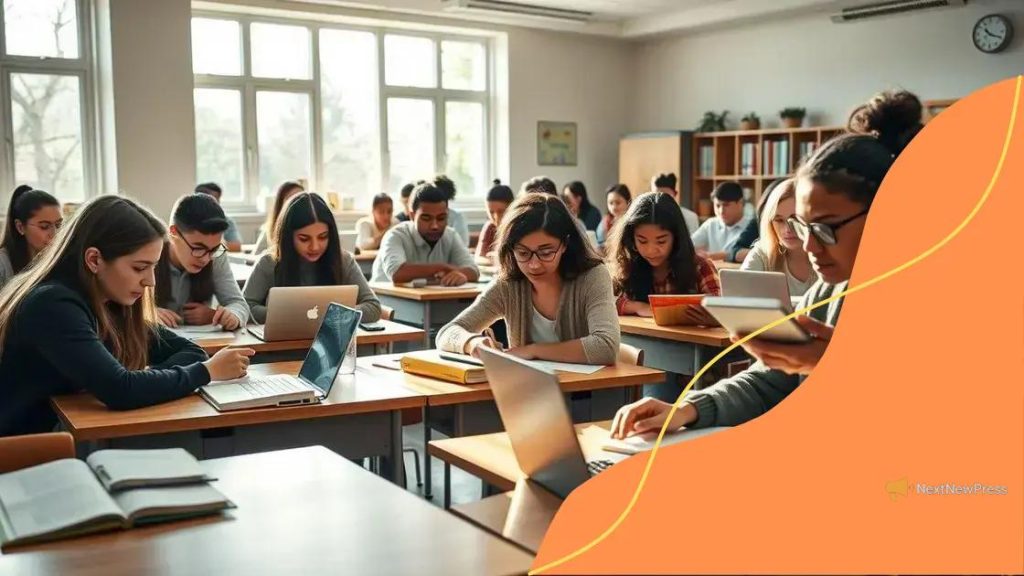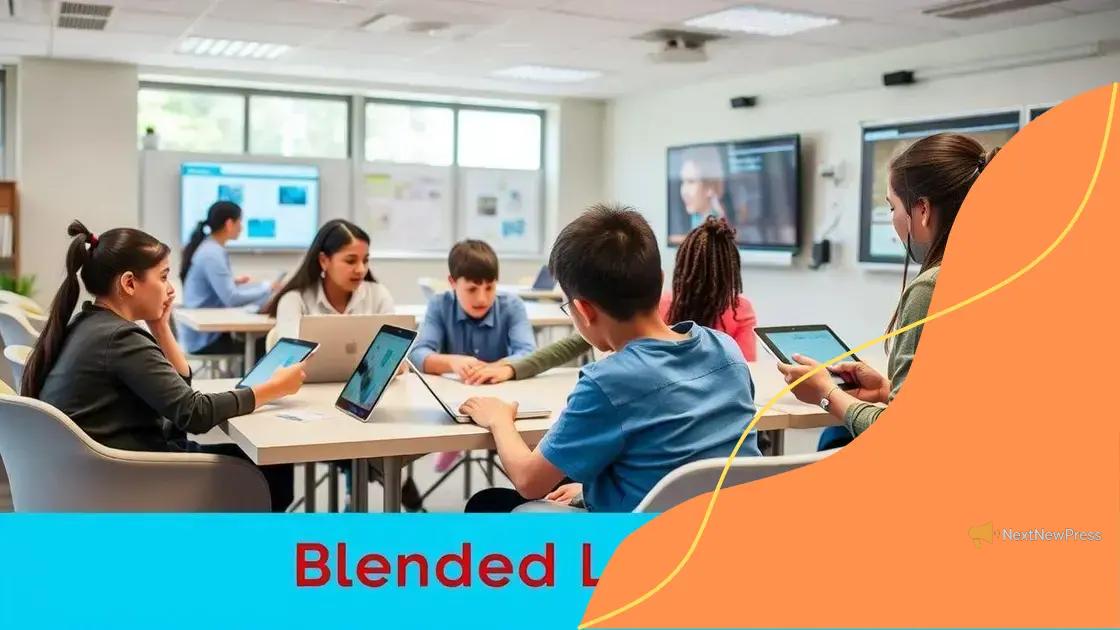Blended learning standards: Enhance your teaching methods

Blended learning combines online and face-to-face education to enhance student engagement and personalization, using technology to foster interactive learning experiences.
Blended learning standards are reshaping education as we know it. Imagine combining the best of online and face-to-face learning to create engaging experiences for students. Ready to dive into how these standards can enhance your teaching?
Understanding blended learning
Understanding blended learning is essential for educators looking to enhance their teaching methods. It combines traditional classroom experiences with online learning, allowing for a more flexible and personalized educational approach.
This model integrates various instructional techniques that cater to diverse learning styles. Educators can facilitate better engagement among students, encouraging them to take ownership of their learning journey.
Key Elements of Blended Learning
To effectively implement blended learning, consider the following key elements:
- Digital content: Utilize online resources such as videos, articles, and interactive activities to reinforce lessons.
- Face-to-face interaction: Schedule in-person sessions to build relationships and clarify complex topics.
- Data-driven decisions: Analyze performance data to tailor instruction and support students’ unique needs.
- Flexible learning environments: Create a classroom space that allows for group work, independent study, and technology use.
Moreover, teachers can blend educational technologies with classroom practices, making learning both engaging and effective. For instance, using discussion forums enables students to participate actively outside of class hours, fostering continuous engagement.
Blended learning also offers the opportunity to personalize instruction. By leveraging online assessments and feedback tools, educators can identify areas where students may struggle and provide targeted resources to help them succeed. This responsive approach promotes a deeper understanding of the material.
Ultimately, understanding blended learning is about embracing a versatile teaching strategy. As classrooms evolve, blending methods will become increasingly essential in meeting the needs of all learners.
Key components of effective blended learning
Key components of effective blended learning are crucial for creating an engaging learning environment. Understanding these elements can help educators design a more impactful educational experience. By intertwining traditional methods with modern technology, teachers can reach a wider range of learners.
One major component is the curriculum design. A well-structured curriculum should include both online and in-person activities. This allows students to experience a diverse set of learning formats. For example, utilizing videos and interactive quizzes can complement in-class discussions.
Technology Integration
Another essential element is technology integration. Tools such as learning management systems (LMS) enable instructors to share resources easily and track student progress. Here are some vital tools that enhance blended learning:
- Learning management systems: Platforms like Moodle or Google Classroom facilitate organization and communication.
- Collaboration tools: Applications such as Google Docs allow students to work together on projects in real-time.
- Assessment tools: Use online quizzes and feedback tools to gauge student understanding continuously.
- Video conferencing: Programs like Zoom or Microsoft Teams support virtual class discussions and meetings.
Additionally, student engagement plays a fundamental role. Effective blended learning requires strategies that maintain student interest and motivation. Teachers can encourage participation through interactive content and varied activities.
Creating a supportive learning environment is also vital. This involves fostering communication between students and teachers. Encouraging discussions, whether online or offline, promotes a healthy exchange of ideas and builds a sense of community.
Ultimately, focusing on these key components will create a successful blended learning experience. As educators implement these strategies, they not only enhance individual learning but also prepare students for the future.
Best practices for implementing blended learning

Best practices for implementing blended learning can significantly enhance the educational experience for both teachers and students. By thoughtfully combining online and face-to-face learning, educators can create a rich and interactive environment.
One of the fundamental practices is to start with clear learning objectives. Establish what you aim to achieve and align your teaching methods with these goals. This creates a roadmap for both educators and students, ensuring that everyone is on the same path.
Choosing the Right Technology
Next, selecting the right technology tools is crucial. Educators should evaluate various platforms and choose those that fit their curriculum and teaching style. Important considerations include:
- User-friendliness: Ensure the platform is easy to navigate for both teachers and students.
- Support resources: Look for tools that offer training and support to aid in the transition.
- Integration capabilities: Select tools that can integrate with existing systems to reduce the learning curve.
- Accessibility: Technology must be accessible to all students, including those with disabilities.
Encouraging student participation is another best practice. Incorporating activities that engage students, such as online discussions or collaborative projects, helps maintain interest and motivation. Frequent interaction with peers fosters a sense of community, which is essential in a blended learning environment.
Moreover, it is essential to provide continuous assessment. Feedback should be timely and constructive, guiding students in their learning process. Using a variety of assessment methods, including quizzes, discussions, and projects, ensures a comprehensive understanding of the material.
Finally, be flexible. Adapt your approach as needed. Each group of students will have different needs and learning styles. Being receptive to feedback and willing to make changes will result in a more effective blended learning experience.
Assessing student engagement in blended environments
Assessing student engagement in blended environments is essential to foster effective learning. Understanding how engaged students are helps teachers shape their instructional methods. There are various strategies to measure this engagement.
One effective way to assess engagement is through observations. Teachers can interact with students during live sessions and monitor their participation. Noticing how often students contribute to discussions or ask questions provides valuable insights.
Utilizing Technology for Tracking
Moreover, using technology tools enhances engagement assessment. Learning management systems (LMS) often have tracking features that allow teachers to see how often students log in and complete assignments. Insights from these tools can identify patterns of engagement:
- Completion rates: Analyze how many assignments each student completes on time.
- Participation metrics: Track how often students contribute to forums or discussions.
- Feedback opportunities: Provide surveys to gauge student satisfaction with the course material.
- Collaboration levels: Assess how well students work together on group projects.
Additionally, engaging students with formative assessments can provide real-time feedback. Tools like quizzes or reflections can help teachers understand if students grasp the materials. The insights gathered help adjust teaching strategies quickly.
Creating a supportive environment encourages students to express their feelings about their engagement levels. Having regular check-ins where students can voice their thoughts gives teachers a clearer picture of overall engagement. Listening to student feedback and adjusting approaches helps create a more inclusive learning experience.
Overall, a combination of direct observations and technology use can significantly enhance the understanding of student engagement in blended learning. By continuously assessing how students are interacting with the material, educators can create a more tailored approach that fosters deeper learning.
Future trends in blended learning
Future trends in blended learning reveal exciting possibilities for education. As technology evolves, so do the methods used in classrooms. Keeping an eye on these trends helps educators adapt their teaching strategies effectively.
One significant trend is the increased emphasis on adaptive learning technologies. These tools use data to personalize learning experiences for students. By assessing individual progress, they can adjust content and pacing, ensuring that each learner gets the support they need.
Integration of Artificial Intelligence
Another trend is the integration of artificial intelligence (AI) in blended learning environments. AI can assist teachers in grading assignments, providing insights into student performance, and even offering personalized tutoring. This allows educators to focus more on fostering relationships and providing targeted support where needed.
- Automated assessments: AI can provide instant feedback on quizzes and assignments, enhancing the learning experience.
- Intelligent tutoring systems: These systems can offer personalized lessons based on student needs, helping them master difficult topics.
- Data analytics: AI tools can analyze student performance data to identify trends and areas for improvement.
- Content creation: AI can help create customized learning materials tailored to different learning styles.
Moreover, the rise of virtual and augmented reality is transforming blended learning. These technologies provide immersive experiences that deepen understanding and engagement. For example, students can explore historical events or scientific concepts in a virtual space, making lessons more impactful.
Collaboration will also evolve, with more global classrooms emerging. Students from around the world can work together on projects through online platforms, fostering cross-cultural exchanges and collaboration skills. This trend encourages students to develop a global perspective, preparing them for a connected world.
As blended learning continues to shape the future of education, embracing these trends ensures that educators remain effective. Staying informed about these developments empowers teachers to create dynamic, engaging, and personalized learning experiences.
FAQ – Frequently Asked Questions about Blended Learning
What is blended learning?
Blended learning combines online educational resources with traditional face-to-face classroom methods, providing a flexible learning experience.
How can technology enhance blended learning?
Technology, such as adaptive learning tools and learning management systems, helps personalize learning experiences and track student progress.
What are the benefits of blended learning?
Blended learning allows for personalized education, promotes student engagement, and facilitates collaboration among students.
How can I assess student engagement in a blended learning environment?
You can assess engagement through observations, analytics from learning platforms, and formative assessments like quizzes and feedback surveys.





